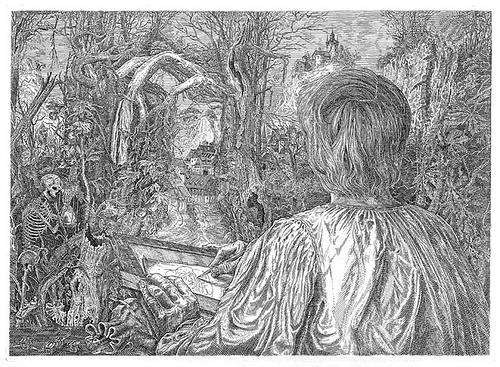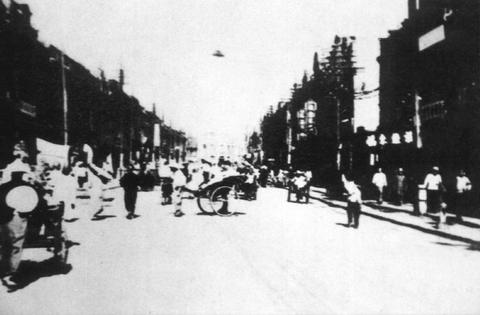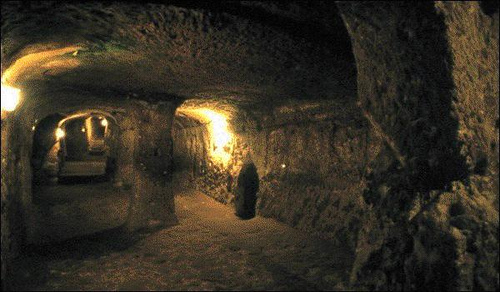
Etching by Hungarian artist István Orosz.
Oscar Wilde said, “Life imitates art far more than art imitates life.”

Etching by Hungarian artist István Orosz.
Oscar Wilde said, “Life imitates art far more than art imitates life.”

No matter how fast a train is moving forward, certain parts of it are moving backward:
The flanges of its wheels.
SIR,—In reference to your paragraph in your yesterday’s issue [of the Malacca Straits Times Overland Journal], relating to our having seen a sea-monster answering to the popular notion of a sea-serpent, I am prepared to vouch for the correctness of the statement already made to you by the doctor and a passenger by my ship.
Being on the bridge at the time (about 10 A.M.) with the first and third officers, we were surprised by the appearance of an extraordinary monster going in our course, and at an equal speed with the vessel, at a distance from us of about six hundred feet. It had a square head and a dragon black and white striped tail, and an immense body, which was quite fifty feet broad when the monster raised it. The head was about twelve feet broad, and appeared to be occasionally, at the extreme, about six feet above the water. When the head was placed on a level with the water, the body was extended to its utmost limit to all appearance, and then the body rose out of the water about two feet, and seemed quite fifty feet broad at those times. The long dragon tail with black and white scales afterwards rose in an undulating motion, in which at one time the head, at another the body, and eventually the tail, formed each in its turn a prominent object above the water.
The animal, or whatever it may be called, appeared careless of our proximity, and went our course for about six minutes on our starboard side, and then finally worked round to our port side, and remained in view, to the delight of all on board, for about half an hour. His length was reckoned to be over two hundred feet.
JOHN W. WEBSTER,
Commander, S.S. Nestor.
Singapore, 18th September 1876.
Some years ago there was a cat-concert held in Paris. It was called ‘Concert Miaulant,’ from the mewing of the animals. They were trained by having their tails pulled every time a certain note was struck, and the unpleasant remembrance caused them to mew each time they heard the sound again.
— Frank H. Stauffer, The Queer, the Quaint and the Quizzical, 1882

Japanese student Masujiro Kiru found this photo in a scrapbook left by his father. Apparently the scene is Tsientsien Street in Hopeh, China, around 1942. UFO enthusiasts note that two people appear to be pointing to an object in the sky. It could be a bird, it could be a hat, it could be man-lizards from Aldebaran. You decide.

In the year 1819, as a cat belonging to Mr. W. Allwork of Goudhurst, was prowling through the meadows, it was observed to kill a partridge, and, on examining the spot, a nest was found, containing eighteen eggs, which were taken up and that evening deposited in an oven that had been recently used. On the following morning, when the oven was opened, the whole of the eggs were found hatched, and the young ones running about, but in catching them three were unfortunately killed; the remaining fifteen were put into the nest, and placed in the meadow where it was taken from on the preceding evening. In a short time the old cock partridge was attracted to the spot, and in a few minutes it departed with the whole brood, in the presence of several persons; since that time they have been freqently seen by the gamekeeper of T. Wallis, Esq.
— “Edinburgh Paper,” cited in The Cabinet of Curiosities, 1824

If you were an early Christian fleeing Roman persecution, Turkey offered more than 200 underground cities, 40 of which contain three levels or more. The largest found so far, in Derinkuyu, has eight floors and extends to a depth of 85 meters, covering as much as 7,000 square feet (some floors haven’t yet been excavated).
It wasn’t a bad life: The larger complexes had rooms for food storage, kitchens, churches, stables, wine and oil presses, and shafts for ventilation. At its height, the city at Derinkuyu could accommodate 50,000 people.
A weird story clings to the ruins of Minster Lovel Manor House, Oxfordshire, the ancient seat of the Lords Lovel. After the battle of Stoke, Francis, the last Viscount, who had sided with the cause of Simnel against King Henry VII., fled back to his house in disguise, but from the night of his return was never seen or heard of again, and for nearly two centuries his disappearance remained a mystery. In the meantime the manor house had been dismantled and the remains tenanted by a farmer; but a strange discovery was made in the year 1708. A concealed vault was found, and in it, seated before a table, with a prayer-book lying open upon it, was the entire skeleton of a man. In the secret chamber were certain barrels and jars which had contained food sufficient to last perhaps some weeks; but the mansion having been seized by the King, soon after the unfortunate Lord Lovel is supposed to have concealed himself, the probability is that, unable to regain his liberty, the neglect or treachery of a servant or tenant brought about this tragic end.
— Allan Fea, Secret Chambers and Hiding-Places, 1908

There’s no color in this image, right? Now scroll down and stare at the colored boxes below. There’s no need to focus on any particular spot, just look at the boxes for a few minutes. Then look at the first image again. The horizontal gratings will look greenish and the vertical gratings pink.
That’s not especially impressive, but come back tomorrow and the effect will still obtain. It’s not a simple afterimage. Print out the grid and carry it around with you. Rotate it 45 and 90 degrees and see what happens. If you invest 10 minutes in looking at the colored boxes, the aftereffect can last up to 24 hours.
No one’s sure what’s behind this phenomenon; its discoverer, Celeste McCollough, thinks the induction temporarily modifies the cells in the visual cortex that respond to color and orientation.

On July 25, 1956, 14-year-old Linda Morgan was in her cabin on the Andrea Doria when it collided with the Stockholm in the North Atlantic. It was feared she had been killed in the disaster: She did not reach any rescue ship, and the Andrea Doria capsized and sank the next morning.
But then a strange story emerged. Shortly after the collision, a crewman on the Stockholm had heard a young girl calling for her mother from behind a bulwark. “I was on the Andrea Doria,” she told him. “Where am I now?”
Apparently the collision had flung her out of her bed and into the other ship. She suffered only a broken arm.